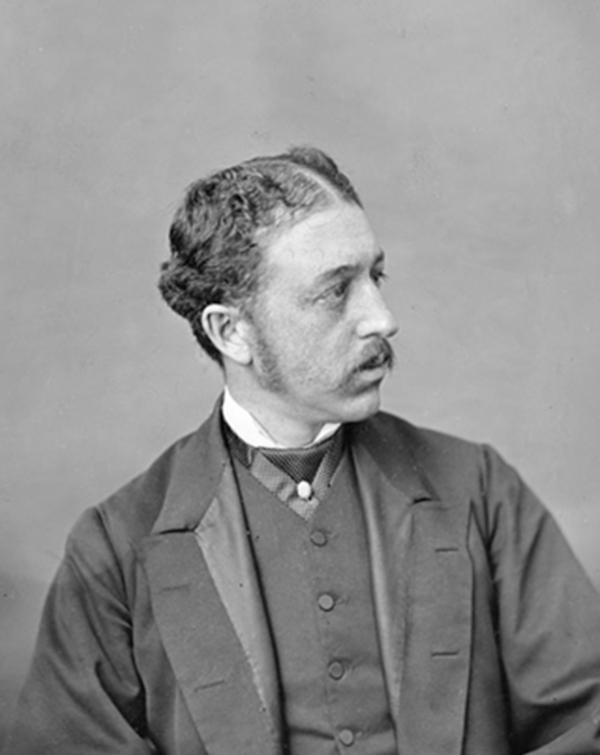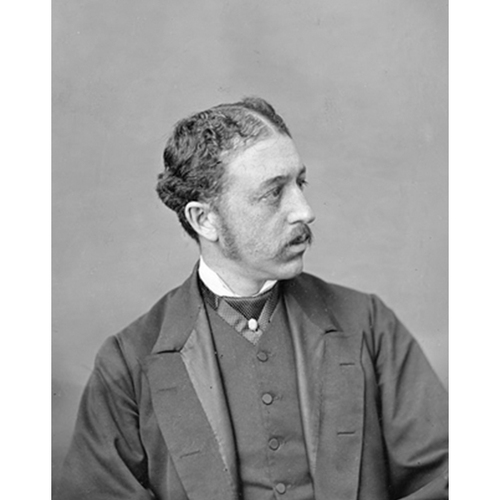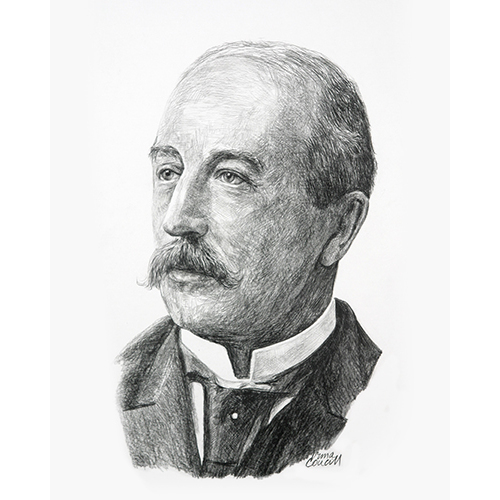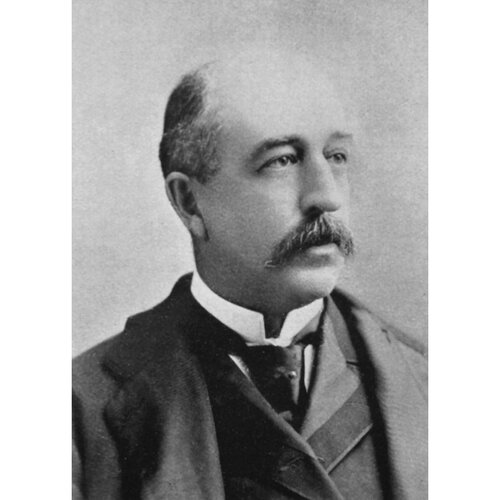
Source: Link
MONTIZAMBERT, FREDERICK, physician and office holder; b. 3 Feb. 1843 at Quebec, son of Edward Lewis Montizambert, a lawyer, and Lucy Bowen; m. there 15 June 1865 Mary Jane Walker, and they had five daughters and two sons; d. 2 Nov. 1929 in Ottawa.
The Boucher de Montizambert family were direct descendants of Pierre Boucher*, the founder and seigneur of Boucherville. After the conquest they intermarried with influential British families in the colony and gradually became anglicized. Frederick, who used only Montizambert as his surname, was raised in the well-to-do and dominant milieu of the Quebec administrative and judicial upper middle class. His father, having practised his profession as a lawyer, was appointed law clerk to the Legislative Council of Lower Canada in 1862 and the Senate in 1867. His maternal grandfather, Edward Bowen*, had been chief justice of the Superior Court of Lower Canada. Frederick attended the High School of Montreal and, from 1856 to 1859, Upper Canada College in Toronto. Having studied medicine at the Université Laval at Quebec from 1859 to 1861, he set out for Scotland in 1863. He specialized in surgery and obstetrics and began training in clinical medicine at the prestigious medical faculty of the University of Edinburgh. In the winter of 1891 he would spend two months at Johns Hopkins University in Baltimore, Md, studying the bacteria of cholera and other contagious diseases, under the direction of Professor William Henry Welch.
On his return to Quebec in 1865, Montizambert married Mary Jane Walker, whose father, William Walker, had been a member of the Legislative Council from 1842 to 1863. In 1866 he obtained a position as assistant physician at the quarantine station on Grosse Île in the St Lawrence River, about 33 miles below Quebec. A sturdy man passionately interested in public health, he turned his back on a promising career in private practice and took on the exhausting task of boarding ships and examining their passengers. The quarantine station, which had been opened in 1832 because of a cholera epidemic, had also had to deal with both the massive emigration of Irish fleeing famine and deadly typhus in the late 1840s [see George Mellis Douglas*]. When Montizambert moved there, preparations were under way to cope with another outbreak of cholera.
When Anthony von Iffland* retired as medical director at Grosse Île, Montizambert applied for and in 1869 obtained this important position. At the age of 26, he faced a huge challenge: to put in place a modern, efficient, rapid, and permanent quarantine system where there existed only dilapidated, rudimentary, temporary wooden huts. The task was all the more urgent because Canada, as constituted by confederation, was counting heavily on immigration to populate and develop the country, and at that time a growing number of contagious and increasingly virulent diseases were threatening to come up the St Lawrence with this immigration, now arriving from all over the world.
Over the course of three decades, in spite of petty administrative annoyances and economic and budgetary crises, Montizambert brought Grosse Île to the front rank of North American quarantine stations. The installations were largely rebuilt and compartmentalized, the quarantine regulations were amended, and reception and service were brought into line with the steamship age. Much more important was the fact that, on Montizambert’s initiative, the station rapidly and radically altered its scientific approach. From the 1880s, on the heels of major discoveries in microbiology, disinfectants and vaccination put an end to lengthy confinement. In 1892 a bacteriological laboratory was built on the island, enabling bacteria of infectious diseases to be quickly identified. In this way, serious illnesses could be distinguished from ordinary infections that could be treated at Quebec. In 1894, while remaining at Grosse Île, Montizambert was appointed by Ottawa to be superintendent of Canadian quarantine stations. As a result of this appointment, the stations on Lawlor Island near Halifax, Partridge Island in New Brunswick, and William Head on the Pacific coast soon adopted the technical and scientific procedures that had been developed on the St Lawrence.
In 1899, when immigration was becoming heavier and more varied than ever, the federal government considered it urgent to set up, within the Department of Agriculture, a section devoted exclusively to public health. Having spent more than 30 years at Grosse Île, Montizambert was immediately chosen to head this section. In Ottawa, he retained control of the quarantine stations and continued to modernize them. Among his new responsibilities, he took a particular interest in leper hospitals [see Alfred Corbett Smith*]. He played an active part in developing a highly effective treatment for leprosy, which was used in New Brunswick and British Columbia. As an adviser to the government on public health, he submitted many recommendations of all kinds, including a commitment by the federal government to the fight against tuberculosis, inspection of health conditions on passenger trains, and funding of bacteriological laboratories. But there was one project especially dear to his heart: the establishment of a real federal department of health. He shared this idea with the Canadian Medical Association, of which he was president in 1907–8. In 1919, soon after the end of World War I, the government finally granted his wish and created the long-desired department. On the heels of this victory, in 1920, Montizambert retired. Now 77 years old, he had spent 54 consecutive years in the service of public health in Canada. Widowed in 1921, he died in Ottawa in November 1929 at the age of 86.
An energetic, stubborn, and visionary physician who was resolutely bent on action, Frederick Montizambert is not usually recognized by Canadian medical historiography, mainly because he spent his whole career in the rarified atmosphere of the civil service. He tried to get his employers to recognize the professional status (and pay the salary) that he knew he deserved. In other countries – where he made a name for himself by taking part in international colloquiums, among other things – his work as a pathfinder and his experience in the field of public health did, however, bring him many distinctions. In 1891 he was elected president of the American Public Health Association. In 1893 France and Mexico also recognized the international scope of his pioneering work by making him an honorary member of the Société Française d’Hygiène and the National Academy of Medicine of Mexico. He became a companion of the Imperial Service Order in 1903 and a companion of the Order of St Michael and St George in 1916.
Shortly before his death, Frederick Montizambert wrote a short article, “The story of fifty-four years’ quarantine service from 1866 to 1920,” Canadian Medical Assoc., Journal (Toronto), 16 (1926): 314–19. His other writings, mainly annual reports to the minister of agriculture, are published in Can., Parl., Sessional papers, reports of the Dept. of Agriculture.
ANQ-Q, CE301-S61, 5 mars 1843, 15 juin 1865. LAC, MG 24, D16, 48: 38745; MG 26, A: 212656-759; H, 165, 228; MG 28, I, 75, 1(b), file 2.5 (mfm.); MG 29, C101; E18, 5: 75-77, 571-81; 11, file 10; RG 11, B1(a), 298; B2, 905, 1135, 1355, 1593; B2a, 1896; D4, 387, 3966; RG 17, A I, 18, no.1550; 27, no.2837; 46, no.4396; 61, nos.5804, 5843; 65, no.6278; A I.1, 15, files 1201-40; A I.5, 1631; A I.9, 1679; A 13, 1975, nos.1-5; RG 29, 4, nos.191525-26, 225273; 5, nos.126293, 233287; 19, file 10-3-1; RG 32, C2, 191, 683. Le Droit (Ottawa), 4 nov. 1929. Ottawa Citizen, 4 Nov. 1929. Geoffrey Bilson, “Dr Frederick Montizambert (1843–1929): Canada’s first director general of public health,” Medical Hist. (London), 29 (1985): 386–400. Canadian men and women of the time (Morgan; 1912). Le Jeune, Dictionnaire. André Sévigny, Étude polyphasique des aménagements de la Grosse-Île: 1832–1980 (Parcs Canada, Direction des lieux et des parcs hist., Travail inédit, [Ottawa], 1991; Rapports sur microfiches, no.477); “Frederick Montizambert, homme-relais de la bactériologie et pionnier de la santé publique au Canada” (copie dactylographiée, Commission des lieux et monuments historiques du Canada, report no.1998–14, Ottawa, 1998), 391–417. Martin Tétreault, “Frederick Montizambert et la quarantaine de Grosse Île, 1869–1899,” Scientia Canadensis (Thornhill, Ont., and Ottawa), 19 (1995): 5–28. Who was who . . a companion to “Who’s who,” containing the biographies of those who died during the period [1897–2000] (10v. to date and an index, London, 1920–?), 3 (1929–40): 959.
Cite This Article
André Sévigny, “MONTIZAMBERT, FREDERICK,” in Dictionary of Canadian Biography, vol. 15, University of Toronto/Université Laval, 2003–, accessed April 28, 2025, https://www.biographi.ca/en/bio/montizambert_frederick_15E.html.
The citation above shows the format for footnotes and endnotes according to the Chicago manual of style (16th edition). Information to be used in other citation formats:
| Permalink: | https://www.biographi.ca/en/bio/montizambert_frederick_15E.html |
| Author of Article: | André Sévigny |
| Title of Article: | MONTIZAMBERT, FREDERICK |
| Publication Name: | Dictionary of Canadian Biography, vol. 15 |
| Publisher: | University of Toronto/Université Laval |
| Year of revision: | 2005 |
| Access Date: | April 28, 2025 |





